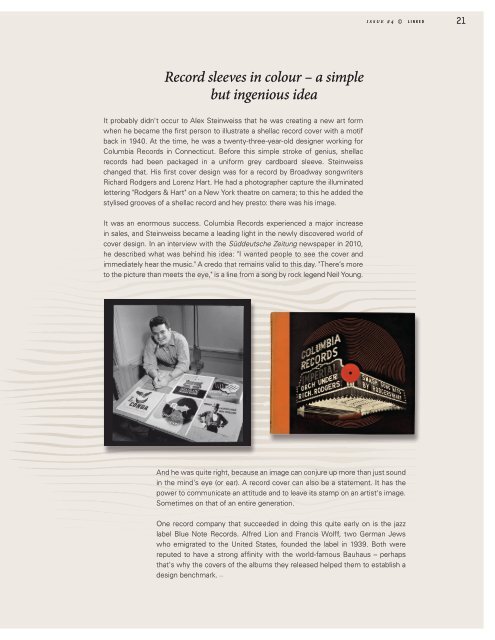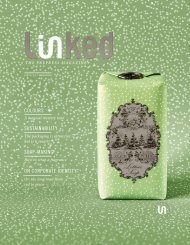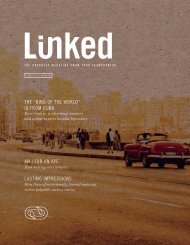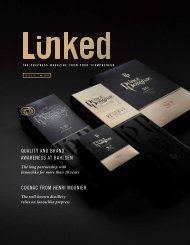Create successful ePaper yourself
Turn your PDF publications into a flip-book with our unique Google optimized e-Paper software.
issue #4 ©<br />
l i n k e d<br />
21<br />
Record sleeves in colour – a simple<br />
but ingenious idea<br />
It probably didn't occur to Alex Steinweiss that he was creating a new art form<br />
when he became the first person to illustrate a shellac record cover with a motif<br />
back in 1940. At the time, he was a twenty-three-year-old designer working for<br />
Columbia Records in Connecticut. Before this simple stroke of genius, shellac<br />
records had been packaged in a uniform grey cardboard sleeve. Steinweiss<br />
changed that. His first cover design was for a record by Broadway songwriters<br />
Richard Rodgers and Lorenz Hart. He had a photographer capture the illuminated<br />
lettering "Rodgers & Hart" on a New York theatre on camera; to this he added the<br />
stylised grooves of a shellac record and hey presto: there was his image.<br />
It was an enormous success. Columbia Records experienced a major increase<br />
in sales, and Steinweiss became a leading light in the newly discovered world of<br />
cover design. In an interview with the Süddeutsche Zeitung newspaper in 2010,<br />
he described what was behind his idea: "I wanted people to see the cover and<br />
immediately hear the music." A credo that remains valid to this day. "There’s more<br />
to the picture than meets the eye," is a line from a song by rock legend Neil Young.<br />
And he was quite right, because an image can conjure up more than just sound<br />
in the mind's eye (or ear). A record cover can also be a statement. It has the<br />
power to communicate an attitude and to leave its stamp on an artist's image.<br />
Sometimes on that of an entire generation.<br />
One record company that succeeded in doing this quite early on is the jazz<br />
label Blue Note Records. Alfred Lion and Francis Wolff, two German Jews<br />
who emigrated to the United States, founded the label in 1939. Both were<br />
reputed to have a strong affinity with the world-famous Bauhaus – perhaps<br />
that's why the covers of the albums they released helped them to establish a<br />
design benchmark.









